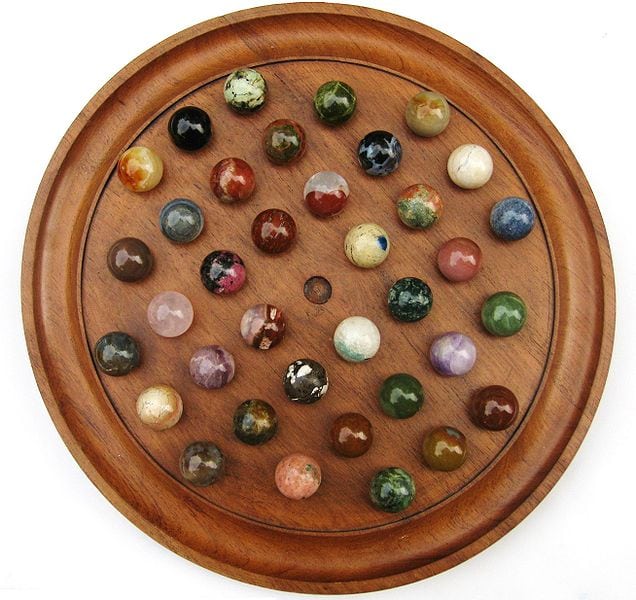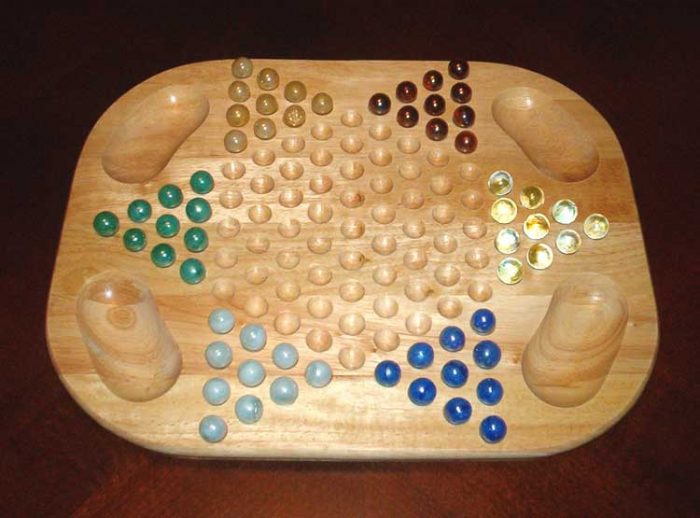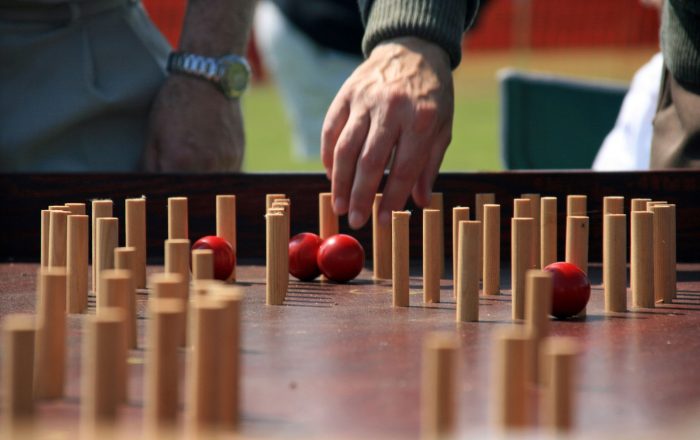
There are actually multiple board games involving balls and holes, including the Chinese checkers, peg (or marble) solitaire, and bagatelle.
How are these games played? Let’s take a closer look at these individual boardgames and discover how you play them.
What’s Peg Or Marble Solitaire (Solo Noble)?

The European variant of the Solitaire board. Photo: Annielogue via Wikimedia Commons, CC-BY-SA 3.0
Peg or marble solitaire, is a game probably invented in France and it involves the moving of marbles or pegs around a board with small holes. The board starts full of marbles except for one spot in the center, and the objective is to remove all the marbles by jumping them over one another until there is only one marble remaining in the center. (Incidentally, the card game Solitaire is known as Patience in the UK). A French engraving of Princess de Soubise seems to show her playing the game, and the engraving seems to date back to 1697, suggesting that the game may have been invented sometime in the late 1600s.
The board game has 33 holes arrayed in a cross formation. 32 of the pegs or holes are filled with marbles, and jumping one marble over the other removes that marble from play. The marbles may only be jumped horizontally or vertically, not diagonally.
If a marble is in the middle of the board, you can jump it in any direction you want. You can only make two possible jobs from the edges of the board, and one jump from the middle rows of the outside edges. There are 76 possible jumps or moves in total. Winning the game, or solving the puzzle, can be rather hard. This is because without a specific strategy you can employ removing all the marbles except one is quite difficult.
“Talent wins games, but teamwork and intelligence wins championships.” — Michael Jordan
There are a variety of different layouts to the board. The English board has three rows and three columns arrayed in a cross formation while the European board has all of these rows and one more marble position is added in each of the four corners. There isn’t a solution to the European-style board if the starting hole is in the center if only orthogonal moves can be made.
The world record solution to the peg solitaire or marble solitaire game consists of only 18 moves, and it was done by E. Bergholt in 1912. Some of the various solutions can be seen here.
What’s Chinese Checkers?

Photo: By Hephaestos at English Wikipedia – Transferred from en.wikipedia to Commons., CC BY-SA 3.0, https://commons.wikimedia.org/w/index.php?curid=2633945
The game that is frequently referred to as Chinese checkers, is actually a board game that likely originated in Germany, where it was called “Sternhalma”. The game can be played with two, three, four, or six players. The board game is laid out in a six-pointed star formation, with each of the points of the star containing marbles that function as the player’s pieces. The goal of the game is to be the first to collect all of one’s pieces in the corner across from one’s starting corner. You can either use single-step moves that jump one marble to an immediately adjacent space or moves that jump over other marbles.
There is actually little information about the origin of the term Chinese checkers. It’s possible that the game was introduced into Asia and China at one point, where it then became known by Americans as a Chinese board game.
“Life is more fun if you play games.” — Roald Dahl
The number of marbles starting on the board depends on the number of players, for a full six-player game all marbles and triangles are used. If there are only four players, the players will begin in two pairs of opposing triangles, and likewise, a game of only two players should be played from their respective opposing triangles. A three-player game has the players start in the triangles which are equidistant from one another. The unused triangles can either be filled with the unused marbles (so those positions are out of play) or left open for use in the game if desired.
When jumping a marble over another marble, the marble must be placed into the hole that is directly beyond it, they cannot be placed in holes adjacent to that. If there are multiple marbles with one space in-between them, a player may hop over multiple marbles in a row. If one he gets lucky, they may even be able to move a marble from their corner to the other corner in a single turn.
Unlike marble solitaire or chess, the marbles are never removed from the board. Once they have reached the triangle on the opposing side, they can only be moved around inside of the triangle, so they cannot leave the triangle once there. There are no official rules regarding whether or not marbles can be moved into a triangle which is a target triangle or starting triangle of another player. There are only house rules regarding these conditions, but a common house rule is that marbles can be hopped through another player’s triangle yet cannot come to rest there.
A common strategy involves finding the path that would allow you to hop your marble as close to the other side as possible, including making multiple jumps over the other player’s marbles. Since both players can create and use hopping chains, one must also guard against this tactic being used against them.
What’s Bagatelle?

Photo: By Nikki Tysoe from London, UK – Uploaded by McGeddon, CC BY 2.0, https://commons.wikimedia.org/w/index.php?curid=9565113
Bagatelle is an indoor game played on a billiards table and derived from billiards itself. The object of bagatelle is to move a number of different balls through wooden pins into a series of holes. There is a penalty for touching or knocking over any of these wooden pins. There are many different versions of bagatelle, with different orientations, hole positions, and tags or pins.
“Play every game as if it is your last one.” — Guy Lafleur
The game was formally called bagatelle sometime around 1819 when the bagatelle board gained standardized dimensions of 7′ x 21″. They could often be found in bars and restaurants across England and much of Europe. Bagatelle games have spun off into different bar billiards games and even children’s bagatelle games.
The basic concept of bagatelle was adapted into the famous pinball machines and Pachinko machines that are often found in arcades. Pachinko machines are typically only found in Japan.








